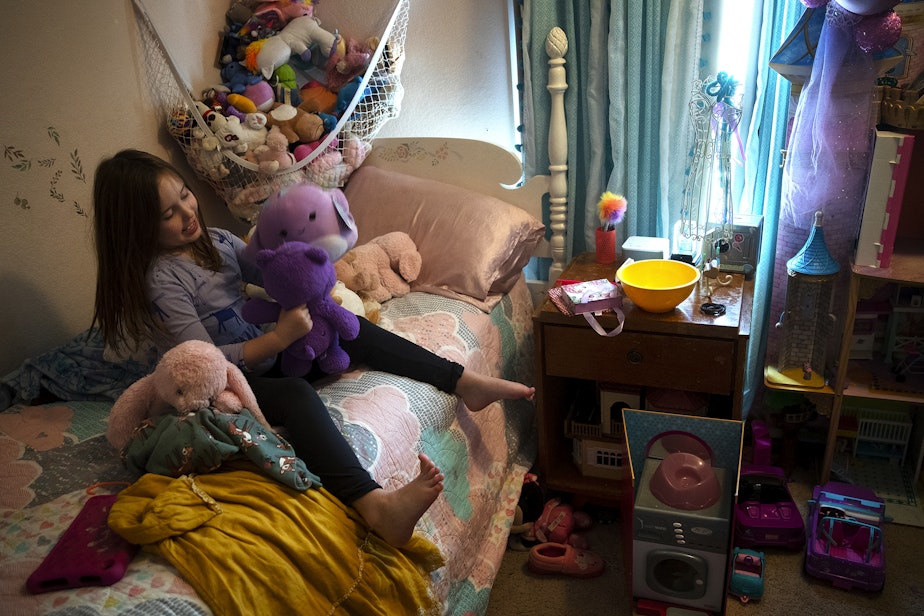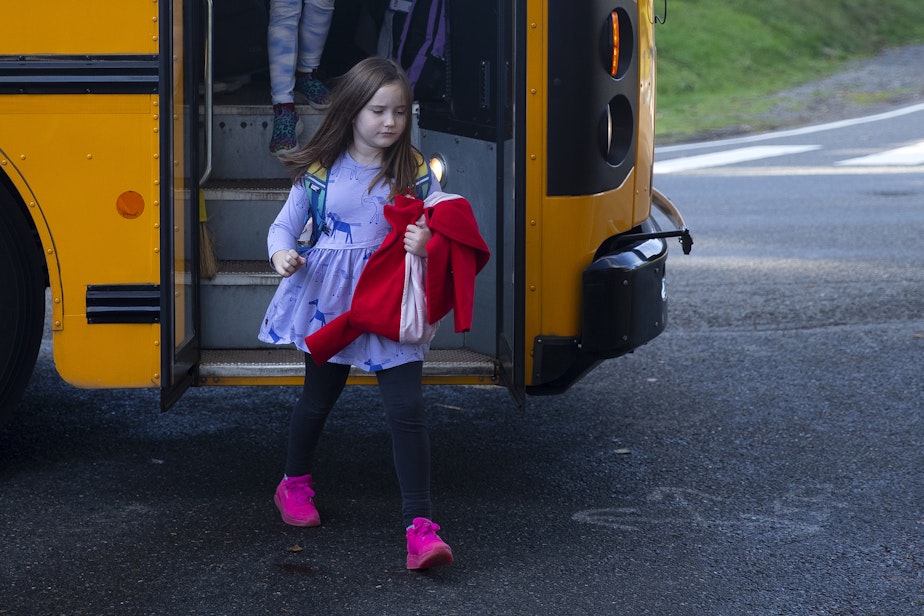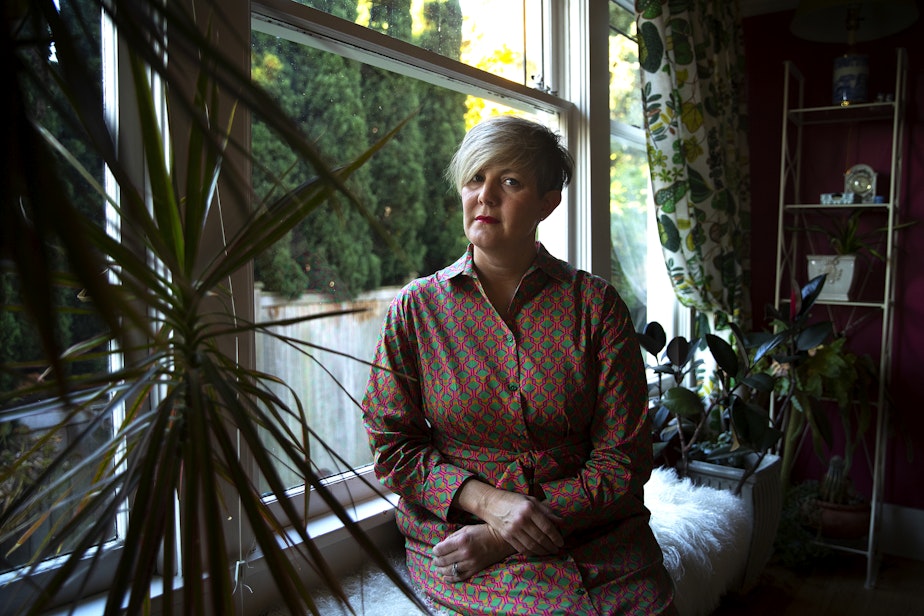The second shift: Child care crisis forces families into grueling schedules

L
ara Allen and Rob Butler couldn’t afford the high cost of child care for their three kids, so they pay with other resources — sleep and time.
Allen works three nights a week as a nurse at the University of Washington Medical Center while Butler takes care of the kids. When she's available to take over child care duties, he schedules clients for his fish-tank business.
“A lot of it ends up being me sleeping less and Rob working less,” Allen said on a recent morning as Butler shuttled their kids to the bus.
Their situation isn’t unusual. Child care costs have spiked 220% since 1990, and the crisis is especially acute in Washington state. It has the fifth-highest average weekly cost of child care in the nation, and Seattle is the second most expensive city, trailing only San Francisco. Even if parents can afford child care or receive government aid, they still face the hurdle of low availability. It’s typical for day cares to have years-long waitlists.
Those headwinds are forcing more families to take work and child care in shifts, according to Deeann Puffert, CEO of Childcare Aware of Washington. But she said that work-child care relay race comes with other costs for families.
“It just puts a real strain, because essentially what ends up happening is despite there being two adults in the home, you end up with the children in a way that feels very single parent,” she said. “You don't get the support of two adults in the home being with the children, but rather you're tag teaming it and creating this handoff system.”
For Butler and Allen, tag teaming wasn’t their first choice. Before they had kids, Butler worked for a large corporate aquarium maintenance company.
“I liked it a lot and it was a good job, but it just wasn't suited to a family schedule,” he said. “We'd have to hire full- time child care and that cuts against the salary pretty sharp.”
It didn’t pencil out, so Butler left and started his own company installing and maintaining fish tanks.
“His business is really limited because of my schedule, and our lives, and it's kind of just how it is right now,” Allen said.
Some parents are forced to trade shifts because there just aren’t day care spots available. Monica Neal works as a therapist four days a week. Her husband often works nights as a police officer in the Tri-Cities. They rely on family to help fill in the gaps. Neal is trying to get their 16-month-old into a preschool program, but she’s facing long waits and high costs.
“What I’ve heard is some waitlists, depending on the school, will go for like three years,” she said. “It's like two years ago, I didn’t even know I was going to be pregnant, let alone like know that I had to sign her up for preschool already. That’s wild.”

Long waitlists and low availability are typical in child care. Despite the high cost of tuition, child care workers often make close to minimum wage, leading to high rates of burnout and attrition. Margins are extremely thin for child care centers because of regulations that mandate employee-to-child ratios. The high cost of staffing, combined with insurance and other expenses, means no one feels like they’re getting a good deal.
Neal has seen that dynamic first-hand. She worked in a Montessori preschool before becoming a therapist.
“It's not fair to the workers and it's not fair to the parents assuming that they're going to get like the most quality care because they think that these people are being paid for quality services,” she said.
The pandemic made all of these challenges worse. Many child care facilities closed and never reopened, reducing the number of spots available. The government did step in to help, but pandemic-era relief funds for child care just dried up.
For Skye Henley, the difference before and after Covid is palpable. She has four kids — two teenagers and two 9-year-olds.
“Our experience with both of those sets of children has been really, really different,” she said. “It has been very illustrative of what is going on in our society and how all of the institutions that used to support families are no longer functioning or functioning extremely poorly.”
Henley used to have drop-in child care at the community center down the road, but it’s closed now. More regular help isn’t in the budget, so Henley and her husband take child care in shifts. She’s an interior designer and her husband works in finance. He starts work at 4 a.m. and she tries to schedule clients in the afternoon. They switch off with the kids, but it doesn’t always work out.

“My kids get hours of television,” Henley said. “My first two, my first batch of children never got TV like that … I'm very, very concerned about how much of that is happening and what that means for our children going forward.”
Henley shared her fears at the kitchen table of her Eastlake house, where her design background shines through with bright colors and bold prints. The home is in an expensive neighborhood, and Henley is still shocked every time the mortgage bill comes. She said that she had to make a choice between paying for her mortgage and child care.
“I definitely can't pay for soccer and my mortgage and some child care,” she said. “I have to pick. So we've chosen soccer and mortgage and putting together this bizarre schedule where my husband is exhausted all the time and we barely see each other.”
Henley acknowledged that her family has advantages that many don’t.
“All I know is that we have every possible privilege, and it's really hard to cobble it all together,” she said.
For families with fewer resources, it’s nearly impossible.
Some parents are forced to leave work entirely, because they can’t find child care for kids with disabilities. And for single parents, there isn’t a partner to trade shifts with.
The child care crisis is a problem with no easy private-sector solution. Parents are already overburdened by costs, so it’s difficult for child care centers to increase tuition to pay employees higher wages. Without higher wages and benefits, it’s hard to maintain the staff necessary to keep day care doors open. Family advocates say the only real solution is for the government to step in to make child care more accessible.
“We’ve all got to hunker down and make some hard choices,” said Puffert, of Childcare Aware of Washington. “This includes families, providers, government — federal and state — business, the whole bunch of us looking at this and going what part can we play in resolving this challenge for our country?”

